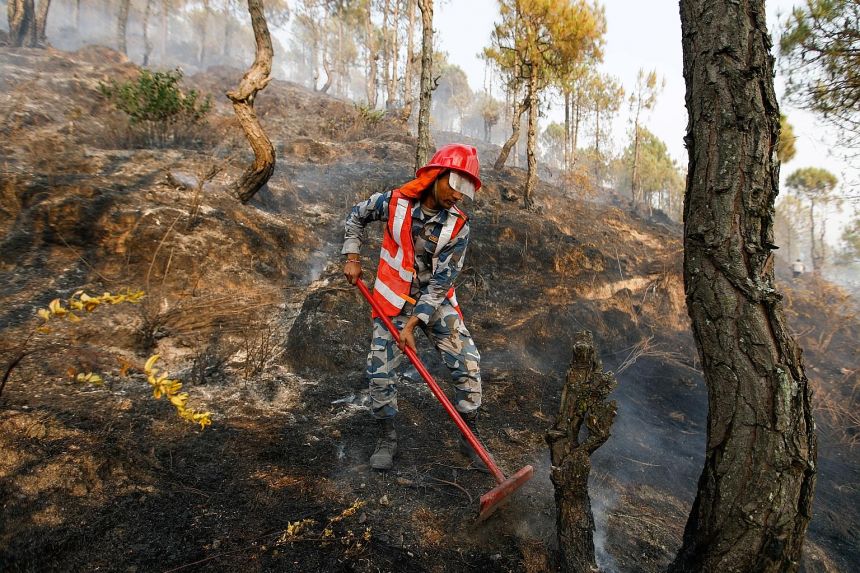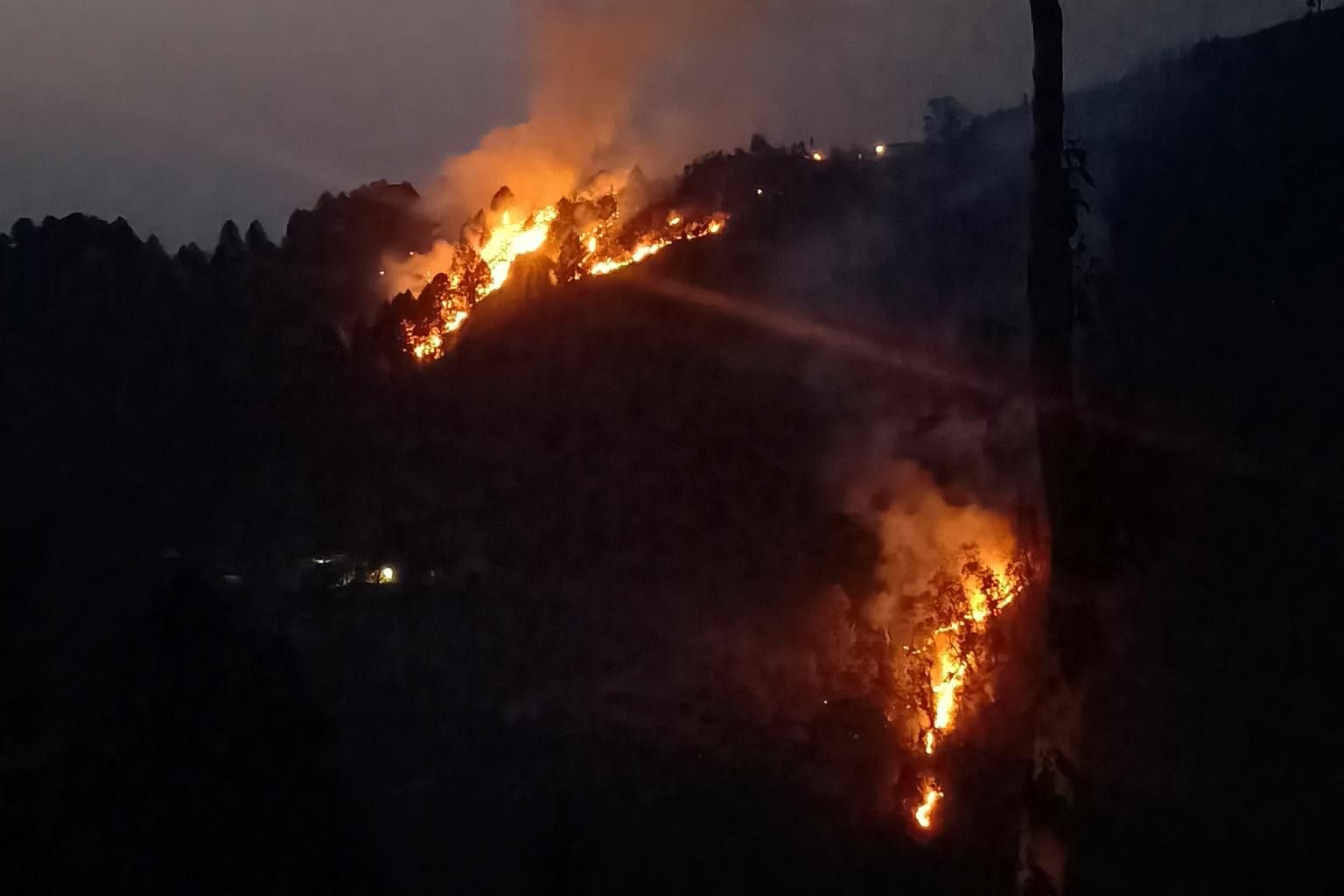Forest fires mount in Indian Himalayan state and climate change blamed
Sign up now: Get insights on Asia's fast-moving developments

A member of Nepal's Armed Police Force working to control a forest fire at Shivapuri National Park overlooking Kathmandu on April 11, 2021.
PHOTO: REUTERS
Follow topic:
NEW DELHI - It is not summer yet but Mr Steve Diederichs, who is originally from South Africa, and his colleagues have already battled four forest fires around their farm in Marrora in the northern Indian Himalayan state of Uttarakhand in the last few weeks.
They have done so with little else other than leafy branches, which they use to beat the fires, and rakes to clear biomass, such as flammable pine needles, to stop the blaze from spreading.
The last fire they had to battle began on the night of April 10. The fire was raging on a hill above their farm and there was little they could do to fight it at that steep elevation. "It was disappointing," said Mr Diederichs. "Just the previous week, we had controlled a fire and we thought we were done. So to see one again was frustrating and soul-destroying."
At the crack of dawn the next day, he and his colleagues set out again to fight the fire that had descended, spending more than 12 hours battling it with several forest guards. This has been a recurring nightmare for many in Uttarakhand in the last few weeks, as wildfires rage across the state that has around 67 per cent of its area covered with forests.
More than 2,000 forest fire incidents have been reported in the state in 2021, killing eight people and affecting more than 2,794ha. Even Nepal has reported a recent worrying spread of wildfires, reported to be the worst in a decade which have left the capital Kathmandu shrouded by smog.
Soaring pre-summer temperatures and an acute deficit in precipitation have contributed to the Uttarakhand forest fires, already said to be the worst since 2016. The state received only 10.9mm of rainfall from January to March this year against the usual 54.9mm for this period, a shortfall of around 80 per cent.
"If there ever has to be a watershed moment in the history of Uttarakhand wildfires, it should be 2021 because it is safe to assume we will most likely cross the maximum record of hectares lost due to forest fires," said Mr Anoop Nautiyal, the founder of Social Development for Communities Foundation, a Dehradun-based think tank. More than 4,800ha was destroyed in 2004.
The impact of these fires is more devastating because the fragile Himalayan ecosystem is home to many endangered species and these fires result in black carbon deposits that accelerate glacial melt. Uttarakhand's "fire season" begins usually around mid-February and lasts until June, when the monsoon sets in. With its peak - around mid-May - yet to come, locals as well as the authorities are worried.
"While there is not much left to burn around the farm now, we are concerned that over the course of the next few months, if it does not rain, the dry matter that gathers will become fuel for the next fire," said Ms Divya Chowfin, who is married to Mr Diederichs and co-founded Himalayan Haat, a social enterprise that sells local produce from their farm.
While there are no "major fires" currently in his division, Mr Koko Rose, the divisional forest officer for the Tehri Forest Division in Uttarakhand, told The Straits Times that they are "still apprehensive because the monsoons are about two months away".
A major blaze was put out in Tehri Garhwal district this week. "Due to higher temperature and very little winter precipitation this year, there is a state of extreme dryness," he said, adding that strong winds and the hilly terrain had made the job of putting out fires more difficult.
These fires are widely suspected to be man-made, often sparked by crop-stubble burning and wind conditions that fan and spread the flames farther. National Disaster Response Force personnel as well as Indian Air force helicopters have been marshalled to douse the flames, reinforcing attempts by locals and forest guards in Uttarakhand.
The state witnessed fires as early as October last year for the first time, with blazes reported through the winter season because of less rainfall, a phenomenon which many experts see as a possible manifestation of climate change.
"The winter wildfire was a clear precursor of what lay ahead," said Mr Nautiyal.

These fires are widely suspected to be man-made.
PHOTO: DIVYA CHOWFIN
Yet, he added, the state's forest department had failed to act on this early warning and generate public awareness in time about the impending forest fire season, including by investing in and getting local forest councils involved in preempting wildfires.
"This is nothing else but a tragic and classic case of widespread systemic failure, aggravated by public apathy towards preserving forests," Mr Nautiyal told ST.
The forest guard corps in the state, which comprises the front-line defence against wildfires, is also severely understaffed. It's sanctioned strength is 3,650 but only 1,552 of these posts are filled. . This prompted the High Court of Uttarakhand to direct the state government last week to fill the vacancies.
Locals have been engaged, in the meantime, as "fire watchers" to tide over the manpower crunch and they work under the supervision of the forest guards.
The blazes have also drawn attention to the absence of real-time air quality monitoring in Uttarakhand and Himachal Pradesh, another state vulnerable to forest fires. Each state has about the same area as the National Capital Region (NCR), which includes Delhi, but neither has a real-time air quality monitor. The NCR has more than 80.
Mr Avikal Somvanshi, who manages the Sustainable Cities Programme for the Delhi-based Centre for Science and Environment, said real-time air quality monitoring that generates pollution data for public use is important not just as part of an early-warning system for forest fires but also for larger public awareness and action.
"These fires have been burning since October, but because these fires do not reach major cities, people do not take much interest," he told ST. "Having real-time pollution data is actually a good tool to get the public take interest in this issue and force authorities to take quick action and be more accountable for it."

